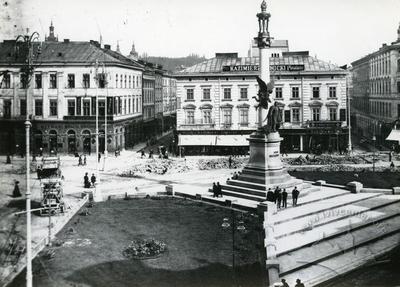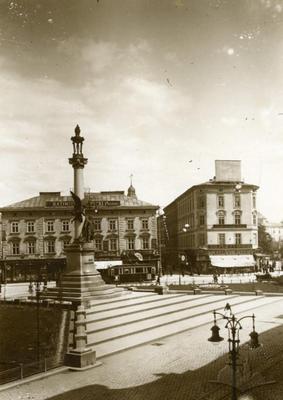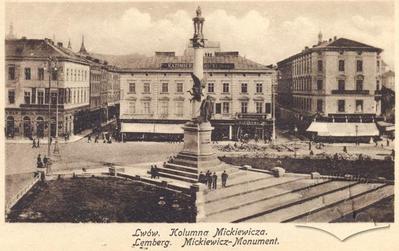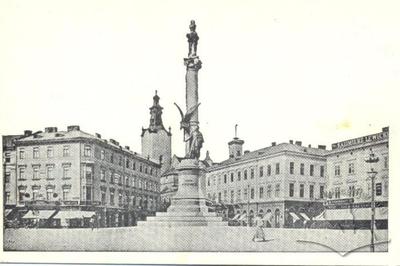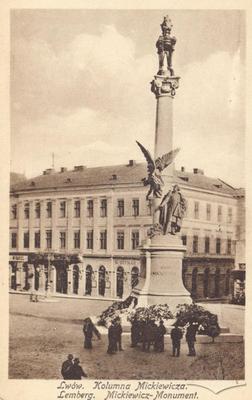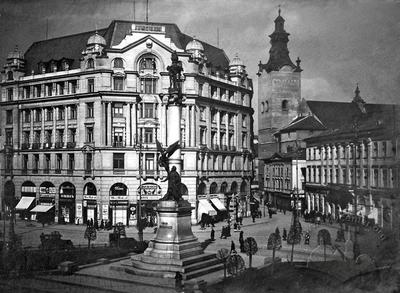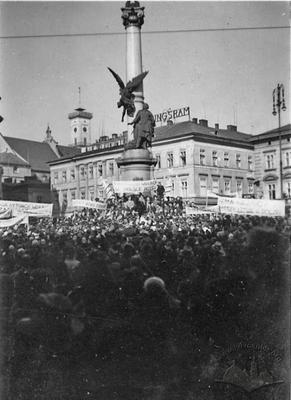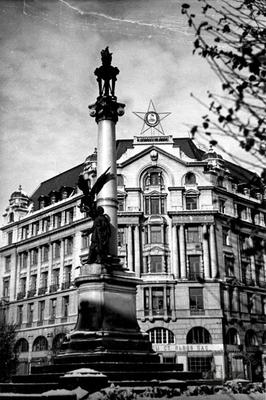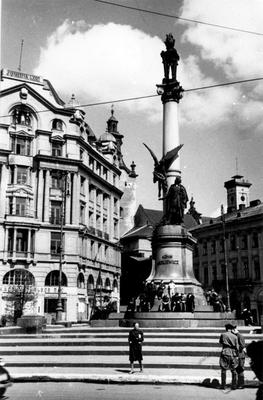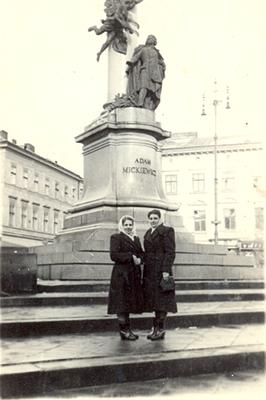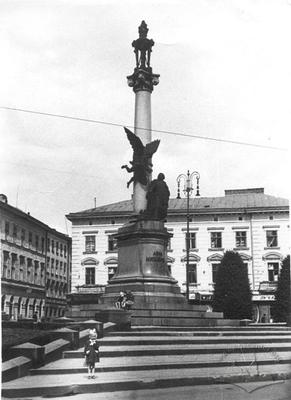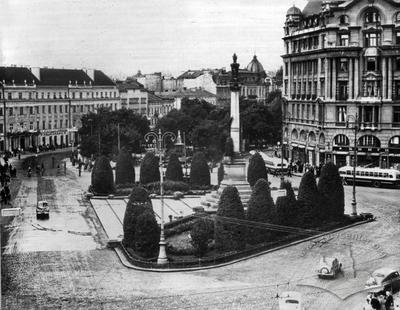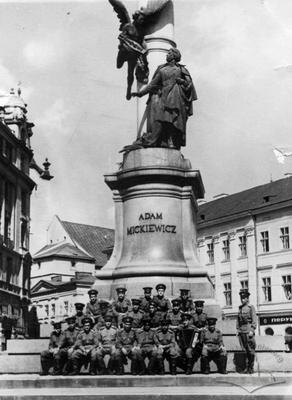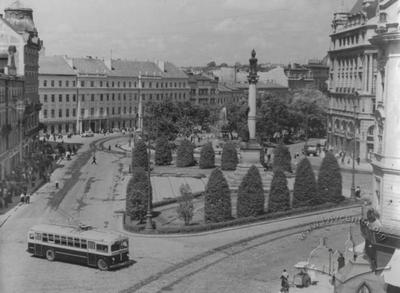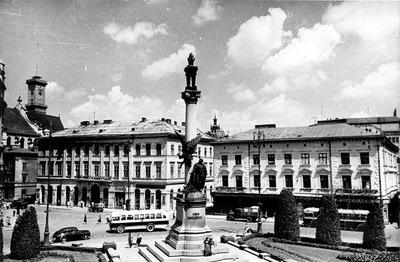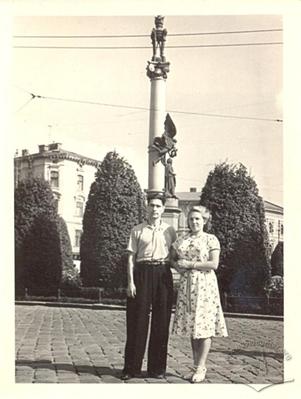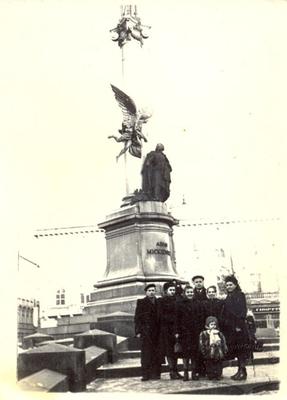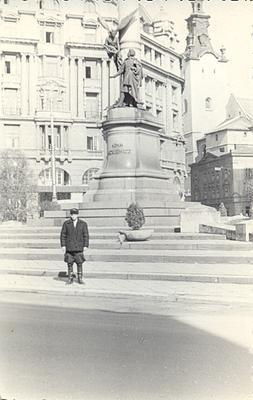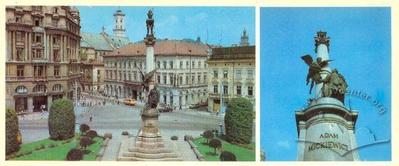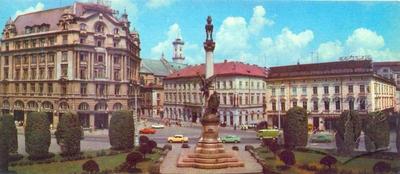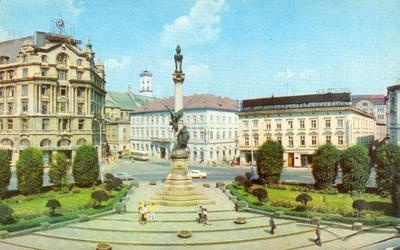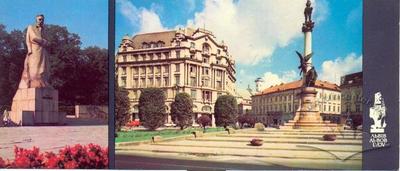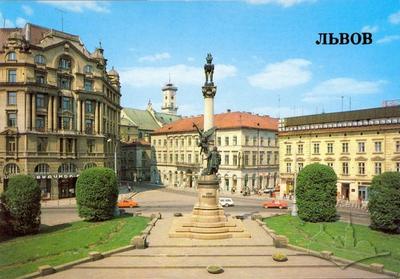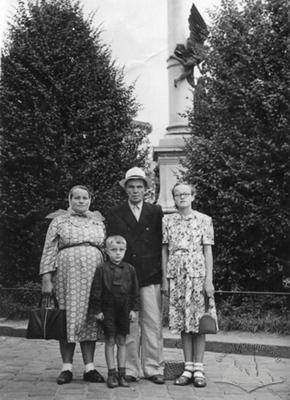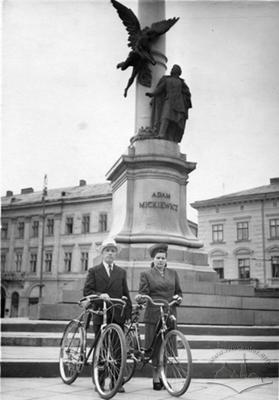Pl. Mitskevycha – monument to Adam Mickiewicz ID: 19
The monument to the national Polish poet was opened on 30 October 1904. Its construction was carried out from late 1903 under the supervision of Alfred Zachariewicz and Józef Sosnowski. The author of the project, who won an architectural competition, was Antoni Popiel, a famous sculptor. Earlier, there was a figure of the Virgin Mary on its place.
Story
The idea to erect a monument to Mickiewicz in Lviv appeared in 1856, a year after the death of the poet. It was at that time that count Edward Stadnicki and Ludwik Skrzyński presented it to count Agenor Gołuchowski, the then governor of Galicia (Kurjer Lwowski, 1904, No. 317, 2). The governor's response was negative for political reasons. However, the idea did not disappear, in particular, in the 1860s, Henryk Schmitt, a historian, made a speech about the need for such a monument in Galicia.
By the end of the 19th c. monuments to the poet were established in many towns of Galicia. In 1888 the Adam Mickiewicz Literary Society was founded in Lviv, headed by Roman Pilat. In 1897 the society formed a special committee to organize the celebration of the centennial birth of the poet (1898). The committee had nine sections: a school, women's, artistic, solemn, labor, youth, financial, donations, and press one. Among other things, the committee planned the installation of a monument. The corresponding construction commission was first headed by Władysław Łoziński, a famous Lviv art historian, collector, and public figure; the commission secretary was Tadeusz Pini (Bieńkowski, 1899, 72). Subsequently, the commission and committee were led by Ludwik Cwikliński (1898-1899) and Bronisław Radziszewski (1899-1904).
The issue of the monument appearance caused lots of discussions among Lviv artists, sculptors, and architects (DALO 3/1/4277:2-3; Bieńkowski, 1899, 72-73; CDIAL 58/1/1:2, 4-6). As a result, the commission decided that the monument should be in a shape of a 20-21 m high column. They believed this shape would make the monument stand out in comparison to the many other monuments in the city.
Among the places for the monument, the Smolki sq. (now Henerala Hryhorenka), the św. Jura sq., ul. Trzeciego Maja (now Sichovykh Striltsiv), Wały Hetmańskie (now prosp. Svobody) were considered, as well as the Maryjska sq. The final decision was made by a separate commission consisting of Ludwik Finkel, Zakrzewski and Kazimierz Zieliński, which chose the last option (CDIAL 58/1/1:9-11, Bieńkowski, 1899, 79; DALO 3/1/4009:7)
A contest was organized and held by the committee, as well as by a jury, which included leading sculptors, artists, and architects (Bieńkowski, 1899, 83; CDIAL 58/1/1:14). The contest was announced in May 1899. To participate it was necessary to send models or drawings on a scale of 1 to 3, as well as a cost estimate, taking into account the cost of materials and not exceeding the amount of 60 thousand Rhenish guilders (Bieńkowski, 1899, 78-79). Twenty three projects were submitted for the contest, mainly from Lviv and the province. The winners were chosen in December 1898: Wacław Szymanowski (Paris) won the third place, Leon Mieczysław Zawiejski (Florence) won the second place, and Antoni Popiel (Lviv) was the winner. He improved his project entitled "Inspiration" and presented the final version of the monument's model at the end of September 1899 (CDIAL 58/1/1:17, 23).
Granite for the column was bought by the Committee from the Pirovano company in Milan, which had supplied this material for the monument to Agenor Gołuchowski in Lviv. The stone was processed by Wiktorya Schimser's company in Lviv. The bronze figures were cast at Teodor Srpek's factory in Vienna.
Fundraising and cost
80 thousand crowns from the city budget were insufficient for the costly monument; therefore, the committee began to raise funds. At first, each of its members donated 50 crowns, and then posts for receiving donations were organized; relevant information was published in the press and on street posters in Lviv and other cities and towns of Galicia. Jan Zieliński and later Kazimierz Peplowski were responsible for fundraising. The collection was joined, in particular, by the Skarbek Theater (Gazeta Lwowska, 1898, No. 251, 3), the Great City Theater (CDIAL 58/1/1:7), the Committee of Polish Women (Gazeta Lwowska, 1903, No. 233, 3), the "Kosmos" periodical (Gazeta Lwowska, 1904, No. 239, 3), the "Bracia Didolicz" company (Gazeta Lwowska, 1904, No. 236, 4), the Heller and Segal shop (Gazeta Lwowska, 1904, No. 240, 3), and many others. In addition, the granite was delivered from Vienna to Lviv at the expense of J. Kobecki (CDIAL 58/1/1: 8); the "Lutnia" Society organized a charity concert (Gazeta Lwowska, 1904, No. 56, 4; No. 71, 3; No. 81, 3; No. 102, 3). Jan Höflinger, a confectionery manufacturer, produced some chocolates and handed over to the Committee the cost of the first 10,000 pieces (Gazeta Lwowska, 1904, No. 216, 4; No. 238; 3; No. 271, 3). The jubilee paper was distributed, produced by the company of Stanisław Wierusz Niemojowski (Gazeta Lwowska, 1904, No. 48, 4, No. 90, 3, No. 98, 3, No. 209, 4). Jubilee cards with an inscription reading "I love the whole people!" were sold in shops (Kurjer Lwowski, 1904, No. 295, 3), as well as flowers, medals with a portrait of Mickiewicz, etc.
The total cost of the monument was 175 571.32 crowns, including the sculptor's fee (40 000), the payment to the Schimser company (82 850), the payment to the Srpek company (29 000), the ground works (9 800), the payment to the architects (9 500), other (4 421.32) (Gazeta Lwowska, 1904, No. 251, 3).
Construction
The construction of foundations was started in the late 1903 under the supervision of architects Alfred Zachariewicz and Józef Sosnowski. The modern Hennebique system of reinforced concrete structures was used. Each of the construction stages was thoroughly covered in the press, in particular by the governmental Gazeta Lwowska. The Mickiewicz statue was installed on 12-14 October 1904 (Gazeta Lwowska, 1904, No. 221, 3; No. 234, 3; No. 235, 3).
The unveiling ceremony
The opening was scheduled for 30 October 1904 (Gazeta Lwowska, No. 229, 1904, 3). The city council allocated additional 20 thousand crowns from the budget and also elected a commission of twelve city council members and three representatives of the Committee to organize the opening. The commission was divided into five sections: the decorative and financial sections, the section for invitations, the section for reception of guests, the section for organizing a march (Gazeta Lwowska, No. 235, 1904, 3-4, No. 238, 3; Kurjer Lwowski, No. 285, 1904, 3).
To attract as many people as possible to the unveiling ceremony, special trains to Lviv from other cities and towns were arranged, with a discount of 40-50%, provided that at least 375 tickets were pre-booked at the same time. If there were more people in certain places, the committee added trailer carriages without the fare discount (Gazeta Lwowska, № 239, 1904, 3, No. 240, 3). Several thousand people from Krakow, Przemysl, Stanislawow, Sambor and Chernivtsi arrived in Lviv in this way (Kurjer Lwowski, No. 302, 1904, 4; CDIAL 58/1/1/28).
Among those invited to attend the opening was Władysław Mickiewicz, the poet's son. He arrived in Lviv on the morning of 28 October. At the invitation of the family of Władysław Gubrynowicz, a bookstore owner, he took part in events held in the Adam Mickiewicz women's and men's schools, visited the Sejm building to take part in the solemn meeting, etc.
The Krakow official delegation at the opening consisted of Julius Leo, the president of the city, and his advisors Ernest Bandrowski, Jan Kanty Fedorowicz, and Jan Rotter (Gazeta Lwowska, 1904, No. 247, 3, No. 249, 3-4).
Reconstruction of the Maryjska square (1906-1909)
Before 1904, there had been a fountain with a stone Virgin Mary figure in the center of the square and a composition of grass beds, clipped bushes, and low trees around. All this greenery was removed, and almost immediately after the opening of the monument the issue arose about the square arrangement. The Magistrate considered three design proposals developed by sculptor Antoni Popiel and architect Teodor Talowski in January 1906. In the first version, it was planned to pave the area with stone from Skole and to install a balustrade and stairs to the monument made of light-colored Ternopil stone. In the second version, instead of the continuous paving of the area it was proposed to arrange grass plots and flower beds. The third version differed from the second one only in the material of stairs (DALO 3/1/4277:33-37,50). The Magistrate's construction department chose the second option, and the city council supported the project of Arnold Röhring, the city gardener. As a result of the discussions, in April 1906, the project of Talowski and Popiel was agreed upon, with a number of corrections: the first step should be at least 24 meters away from the houses, only the herbaceous plants (no flowers) should be planted near the monument, the back stairs should be rounded (DALO 3/1/4277:42-49). The arrangement of the square under this project was completed in 1909.
Restoration of the monument (2006)
From 2006 the monument was restored at the expense of Polish donors under the patronage of Grażyna Staniszewska, a deputy of the European Parliament and a member of the EU-Ukraine Commission. The area around the monument was rearranged, renewal works were carried out and four lights were installed.
Symbolism
"The Mickiewicz Column has become a symbol of Lviv's national feelings. It was in front of it that the Lvivites manifested all their sadness and joy. It was from this column that the children of Lviv went to fight for independence; in front of it they were protesting against the shaitan resolutions of the Brest Peace; finally, in front of it the emblem of Lviv was decorated with the Virtuti Militari Order.
For the inhabitants of Lviv, Mickiewicz always was, is and will be an embodiment of the most noble ideal of love for the Motherland and self-sacrifice. The city has closed him in its heart, the city always accessed by everything most beautiful and noblest, the city of greatest modesty and unparalleled self-devotion... Semper fidelis" (Semkowicz, 1932, 366).
Architecture
The monument is made in the form of a composite order column, with a high granite pedestal on which the bronze statue of Adam Mickiewicz is installed. A figure of a winged genius, handling the poet a lyre, is attached to the column. On top of the capital, there is a "burning" lantern. Metal letters on the front of the pedestal bear the inscription Adam Mickiewicz; in the rear, there is a large bronze cartouche with the coats of arms of Lithuania and Poland.
The monument is placed in the middle of an island in the form of a trapezoid with rounded corners. Wide stairs with low sandstone balustrades lead to it on two sides. On the sides, there are symmetrical grass plots with dwarf bushes around the perimeter. The monument is made of Milan granite and bronze.
People
Ernest Bandrowski — the vice-president of the city of Krakow, a representative of the
official Krakow delegation at the opening of the monument.
Władysław Belza — a member of the Adam Mickiewicz Literary Society in Lviv.
Wilhelm Bruchnalski — a member of the Adam Mickiewicz Literary Society in Lviv.
Ludwik Cwikliński — a member of the committee for the construction of the monument.
Jan Kanty Federowicz — the vice-president of the city of Krakow, a representative of the
official Krakow delegation at the opening of the monument.
Ludwik Finkel — a member of the Adam Mickiewicz Literary Society in Lviv.
Cyprian Godebski — a famous Polish sculptor who worked in Paris, a member of the jury
of the contest for the monument project.
Agenor Gołuchowski — the governor of Galicia in 1866-1868, 1871-1875.
Zygmunt Gorgolewski — a famous Lviv architect, a member of the jury of the contest for the
monument project.
Władysław Gubrynowicz — the owner of a bookstore who was well-known in Lviv.
Juliusz Hochberger — the chief architect of Lviv, a member of the jury of the contest for
the monument project.
Jan Höflinger — the owner of a famous confectionery factory in Lviv.
Józef Kallenbach — a member of the Adam Mickiewicz Literary Society in Lviv.
Adam Krechowiecki —a well-known Lviv journalist, a member of the
Adam Mickiewicz Literary Society in Lviv and the Committee for the construction
of the monument.
Roman Lewandowski — a member of the jury of the contest for the monument project.
Juliusz Leo — the president of the city of Krakow, a representative of the
official Krakow delegation at the opening of the monument.
Władysław Łoziński — a famous Lviv historian of arts, a collector and public figure, the
chairman of the Committee for the preparation of the celebration of Adam Mickiewicz's centennial birth.
Julian Makarewicz — a famous Lviv artist, a member of the jury of the contest for the
monument project.
Władysław Mickiewicz — the poet's son, a participant of the opening ceremony.
Stanisław Wierusz
Niemojowski — the owner of a paper mill in
Lviv.
Kazimierz Peplowski — the second treasurer of the Committee.
Roman Pilat — the head of the Adam Mickiewicz Literary Society in Lviv, a member
of the committee for the construction of the monument.
Tadeusz Pini — the secretary of the Committee for the preparation of the celebration of Adam Mickiewicz's centennial birth.
Wiktorya Schimser — the owner of a company.
Henryk Schmitt — a Polish historian who supported the autonomy of Poland, one of the
activists who called for the establishment of a monument to Mickiewicz.
Ludwik Skrzyński — a co-author of the first appeal to the governor of Galicia containing
the idea of installing the monument to Mickiewicz in 1856.
Józef Sosnowski — an architect, one of the managers of the construction works.
Teodor Srpek — the owner of a Viennese factory which cast the bronze figures of the
monument.
Edward Stanicki — a count, a co-author of the first appeal to the governor of Galicia containing
the idea of installing the monument to Mickiewicz in 1856.
Jan Styka — a renowned Polish artist, a member of the jury of the contest
for the monument project.
Wacław Szymanowski — a Polish carver and artist who lived and worked in Paris.
Teodor Talowski — a well-known Polish architect from Krakow who worked for some time
in Lviv and, together with Antoni Popiel, designed a project to arrange the
area around the monument in 1906.
Pius Weloński — a member of the jury of the contest for the monument project.
Piotr Wojtowicz — a famous Lviv sculptor, a member of the jury of the contest for the
monument project.
Leon Mieczysław Zawiejski — a Polish artist and carver
who lived and worked in the USA and Italy.
Alfred Zachariewicz — an architect, one of the managers of the construction works.
Julian Zachariewicz — a renowned Lviv architect, a member of the jury of the contest
for the monument project.
Kazimierz Zieliński — the Committee treasurer.
Sources
- Державний архів у Львівській області (ДАЛО) 3/1/4009;
- ДАЛО 3/1/ 4277;
- Центральний державний історичний архів України у Львові (ЦДІАЛ) 58/1/1;
- ЦДІАЛ 58/1/5;
- ЦДІАЛ 58/1/7;
- "Pomniki Mickiewicza", Czasopismo techniczne, 1899, 19-20, 30-31
- "Na pomnik Adama Mickiewicza we Lwowie…", Gazeta Lwowska, 1898, №251, 3;
- "Pomnik Mickiewicza", Gazeta Lwowska, 1904, №16, 3;
- "Pomnik Mickiewicza", Gazeta Lwowska, 1904, №24, 3;
- "Papier Mickiewiczowski", Gazeta Lwowska, 1904, №48, 4;
- "Wielki koncert Mickiewiczowski", Gazeta Lwowska, 1904, №56, 4;
- a href="http://jbc.bj.uj.edu.pl/dlibra/docmetadata?id=26518&from=publication">"Na pomnik Mickiewicza…", Gazeta Lwowska, 1904, №71, 3;
- "Na rzecz pomnika Mickiewicza we Lwowie", Gazeta Lwowska, 1904, №81, 3;
- "Papier Mickiewiczowski", Gazeta Lwowska, 1904, №90, 3;
- "Papier Mickiewiczowski", Gazeta Lwowska, 1904, №98, 3;
- "Na rzecz kolumny Mickiewicza", Gazeta Lwowska, 1904, №102, 3;
- "Budowa kolumny Miczkiewicza", Gazeta Lwowska, 1904, №133, 4;
- "Kolumna Mickiewicza we Lwowie", Gazeta Lwowska, 1904, №138, 3;
- "Kolumna Mickiewicza", Gazeta Lwowska, 1904, №144, 4;
- "Kolumna Mickiewicza", Gazeta Lwowska, 1904, №151, 3;
- "Pomnik Mickiewicza", Gazeta Lwowska, 1904, №209, 4;
- "Pomnik Mickiewicza", Gazeta Lwowska, 1904, №212, 5;
- "Pomnik Mickiewicza", Gazeta Lwowska, 1904, №216, 4;
- "Statua Matki Boskiej", "Pomnik Mickiewicza", Gazeta Lwowska, 1904, №221, 3;
- "Odsłonięcie kolumny Mickiewicza", "Na pomnik Mickiewicza", Gazeta Lwowska, 1904, №229, 3-4;
- "Postać Mickiewicza", "Koncert Mickiewiczowski", "W biurze pomnikowem...", "Na pomnik Mickiewicza", Gazeta Lwowska, 1904, №234, 3;
- "Pomnik Mickiewicza", "Na odlew geniusza", Gazeta Lwowska, 1904, №235, 3;
- "Pomnik Mickiewicza", "Czekolada Mickiewiczowska", Gazeta Lwowska, 1904, №238, 2-3;
- "Pomnik Mickiewicza", Gazeta Lwowska, 1904, №239, 3;
- "Pomnik Mickiewicza", "Portrety Mickiewicza", Gazeta Lwowska, 1904, №240, 3-4;
- "Pomnik Mickiewicza", "Ostatnie posiedzenie...", "Zaproszenie na uroczystość...", Gazeta Lwowska, 1904, №244, 3-4;
- "P. Władysław Mickiewicz...", "Pomnik Mickiewicza", "Związek...", "Czytelnia katolicka...", "Wydział Gwiazdy...", Gazeta Lwowska, 1904, №248, 3-4;
- Michał Rolle, "Kolumna Adama Mickiewicza we Lwowie", Gazeta Lwowska, 1904, №250, 2-4;
- Michał Rolle, "Kronika budowy kolumny Adama Mickiewicza we Lwowie (dokończenie)", Gazeta Lwowska, 1904, №251, 3;
- "Na pomnik Mickiewicza…", Gazeta Lwowska, 1904, №271, 3;
- "Koncert ludowy ku czci Mickiewicza", Kurjer Lwowski, 1904, №295, 2;
- "Odsłonięcie pomnika Mickiewicza","Odezwa do wszystkich ziomków z powodu odsłonięcia pomnika Mickiewicza",Kurjer Lwowski, 1904, №300, 2-3;
- "Lwów 30 X 1904",Kurjer Lwowski, 1904, №302, 1-5;
- "Sprawa pomnika Mickiewicza we Lwowie w r. 1856", Kurjer Lwowski, 1904, №317, 2
- Adam Bieńkowski, "Kronika mickiewiczowska", Rok Mickiewiczowski: Księga pamiątkowa (Lwów: Nakładem księgarni H. Altenberga, 1899), 703;
- Aleksander Semkowicz, "Kult Mickiewicza we Lwowie", Studia Lwowskie, (Lwów, 1932), 351-366
- Jurij Smirnow, Stuletni jubileusz pomnika Adama Mickiewicza we Lwowie, (Lwów, 2005), 31
- Ігор Сьомочкін, "Пам'ятник Міцкевича у Львові", Галицька Брама, №9 (33), 1997
- Ігор Сьомочкін, " Площа Міцкевича", Галицька Брама, №9 (33), 1997
- Пам'ятник Міцкевичу у Львові перевірять рентгеном, ZIK, 2006
Citation
Roman Masyk. "Pl. Mitskevycha – monument to Adam Mickiewicz". Transl. by Andriy Masliukh. Lviv Interactive (Center for Urban History 2008). URL: https://lia.lvivcenter.org/en/objects/monument-mitskevych/This text is written on the basis of Roman Masyk's M.A. thesis "Lviv Monuments from the second half of nineteenth century till the 1980s"
Urban Media Archive Materials
